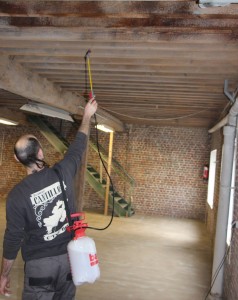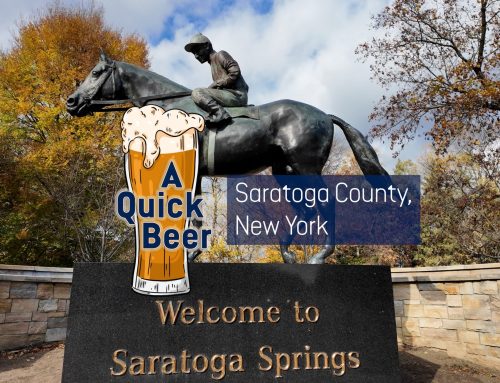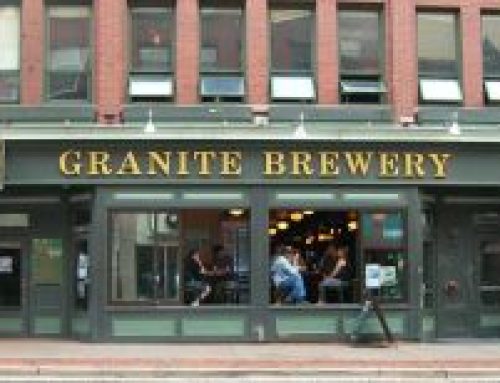Author
Craig
Share
In recent years craft brewing has undergone quite the renaissance. Hundreds of new brewers, thousands of new beers and countless loyal craft beer drinkers. Behind the scenes, a second revolution is starting to take shape: The craft growers, cultivators and producers of craft beer ingredients. As part of a three-part series, I’m taking a closer look at a handful of these less-heralded players in the craft beer industry. This time I’m profiling a promising young company by the name of Escarpment Laboratories.
Of the four primary ingredients in beer, none has as great an impact on beer as yeast. It gives a saison its peppery zip and a hefeweizen its notes of bananas and cloves. Different strains of yeast lend an incredible range of attributes to beer, from the clean crispness of a bohemian pilsner to the complex layers of flavour found in a Belgian quad. It even has an important role to play in styles where it doesn’t come to the forefront, such as the you-might-as-well-gargle-hops American India Pale Ales that are pretty much ubiquitous with craft beer these days. John Kimmich, the brewer behind Heady Topper, which is pretty much the pinnacle of the style, has been known to credit the so-called Conan yeast strain as the factor that sets his beers apart. There’s also the all-important contribution of alcohol to the finished product, which cannot be overlooked.
For all its importance, yeast is easily the least-understood ingredient in beer. For most of beer’s history yeast was a complete mystery. It was first observed by Dutch naturalist Anton van Leeuwenhoek in 1680, who didn’t recognize it as a living organism but rather “globular structures” of some sort. The process of fermentation wasn’t known to be caused by microorganisms until 1857, when Louis Pasteur published Mémoire Sur La Fermentation Alcoolique. Keep in mind that beer is old. Very, very old. It has been mentioned in countless historical texts, from ancient Egyptian hieroglyphs to The Epic of Gilgamesh, The Hymn of Ninkasi and The Bible . The oldest known recipe for beer was found on the Ebla Tablets, which date to around 2500 BC, but archaeological findings indicate that beer was being made in China as far back as seven thousand years ago. That means that we’ve only known about a critical ingredient in beer for maybe 2% of its history!
The reality is that beer was an accident that must have appeared at various times and places throughout history, shortly after a civilization started cultivating grains. The advent of beer was inevitable, thanks to the inherent properties of yeast. Yeast can be found almost anywhere: It’s found on apples, it’s found in fields, it floats through the air and on one occasion it was found in a brewmaster’s beard. All it takes for fermentation to take place is for some of that airborne yeast to come in contact with some water and a source of sugar, such as barley. Early beers were probably the result of a sort of porridge that someone left lying around long enough that it started to ferment spontaneously thanks to some airborne yeast. Someone, somewhere, was hungry enough to choke down the bubbly goop anyway and it made them feel good. From there it’s just a matter of repeating and refining the process to eventually get to something that we would recognize as beer.
Over the next 6600 years or so, most of what we learned about yeast was attributed to a mix of magic and superstition. For example, early brewers figured out that re-using fermenting vessels without cleaning them between batches produced better results, but they had no way of knowing that was due to the residual yeast. Over the years this led to a lot of brewing traditions that brewers underwent without understanding the reasons for them, such as Lambic brewers washing the walls of a new brewery with beer before producing beer in it.
Industrial production of yeast didn’t get started until relatively recently. Yeast companies started popping up simultaneously in the 1800’s all over the Western world. The oldest Canadian example I can find is Lallemand, which was founded in Montreal at the end of the 19th century by a French immigrant. As the makers of the Danstar brand of yeast, they’re easily the biggest (partly) Canadian name in the industry. Skipping over a hundred or so years of technical and scientific innovation, the modern yeast industry for beer got going in the 1980’s with the founding of companies like Wyeast and White Labs. While the craft beer industry was experimenting with new styles and ingredients, companies like these were experimenting with newly discovered and exotic yeast strains. They have been very successful, to the point that the current beer yeast market is dominated by only a handful of companies. At this point, calling those companies “craft” is a stretch, simply due to their size. However, there’s another group of emerging yeast companies that are worthy of the label, which tend to focus on exotic and wild strains of yeast that have funky or sour flavour profiles. One of these companies just happens to be starting up in our backyard: Escarpment Labs.
I sat down with co-founders Angus Ross and Richard Preiss over pints of Richard’s home brew gose (which, by the way, was excellent. If Richard ever offers you a beer you should drink it). Currently finishing up masters degrees in microbiology and molecular biology in a program offered by the University of Guelph that specializes in yeast, these guys are uniquely qualified to get into the yeast game. They actually met working in a yeast lab, where they discovered they had common interests, or, as Richard put it “beer, food, arguing about beer and food.” In a program that most people enter to either further a career in education or to get into scientific research, these guys knew from the start they wanted to apply what they learned to beer. At first they started experimenting with yeast at the home brew scale, mostly as a hobby. Then they started thinking about how the stuff they were learning about in school and tinkering with at home could be applied to the professional scale.
At that point it was really exploratory. We were working with Royal City, but then we also approached Wellington, and Block Three and a few other local breweries. We wanted to see what they were interested in and if they would try out some of our yeast or some of our ideas and thankfully they did. I think that really gave us the confidence to start to pursue it as a serious business.
-Richard Preiss
From there they explored working out of a local brewery. Royal City didn’t have the space and Sonehammer – then F & M – didn’t work out for one reason or another, but eventually they talked to Wellington, who ended up being the ideal partner. As one of the oldest brands around and a member of the OCB they know pretty much everyone in the industry. They’re also a 24-hour brewery, so there’s always some wort around. Better still, they actually already had a lab of their own that they use to do quality control (QC) and they were willing to share.
Escarpment have banked three hundred strains of yeast and counting, which is enough to make pretty much any and every style of beer. Where would an aspiring young company get their hands on that many strains of yeast, you might wonder? It turns out that nobody really owns patents on most commercial yeasts, so just having a beer made with one is usually enough to a viable sample from, which you can then bank, grow and eventually sell. It took them years, starting out saving the dregs from good beers they tried, eventually growing that into a formidable collection of strains. More exotic stuff, like Brettanomyces (aka Brett), the provider (and I swear these are all positive flavours) of funky, horse-blanket and well, manure aromas, or Lactobacillus (aka lacto), the most common souring strain which is technically a bacteria, not a yeast, tended to come from rarer bottles of beers. A mixed-fermentation beer like a Lambic or American Wild Ale could be a gold mine, yielding four or five rare strains each. They’ve also put some effort into isolating some truly wild strains, taking samples from local apple orchards or hop farms to get their hands on some really unique flavours.
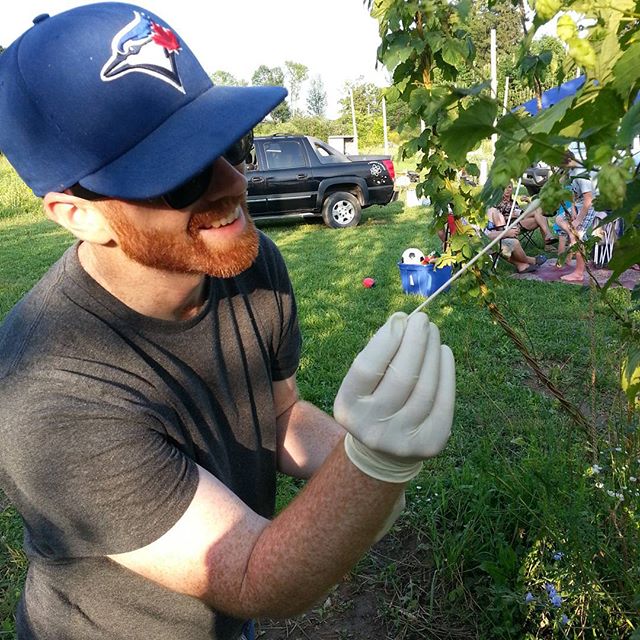
As far as I know, there’s no reason whatsoever to harvest yeast from hops over any other source other than it’s kinda neat.
When I talked to a hop farmer, she gushed about the terroir of Ontario hops. The yeast guys were a little split on whether Ontario yeast has a distinctive flavour. According to Richard, the dominant character in all wild yeast from everywhere in the world is that they are, well, wild. Wild strains are high ester and phenol producers (phenols being volatile organic compounds and esters being chemical compounds that are normally derived from phenols, both produce a wide range of flavours in beer) and have wildly different fermentation characteristics. Some wild yeasts will quit at 2 or 3% alcohol, where others will ferment things up to 8% or higher. Angus is also reserved, but maybe a little more optimistic.
I’d say that we don’t actually know yet. We haven’t tested enough different wild Ontario strains to really have a clear picture of what the flavour profile of Ontario yeasts. I think we’re hoping to find an Ontario characteristic but we’ve really only moved forward with commercialization of one or two wild strains. I think in the future with a larger sample size of things that ferment well we may uncover there’s a terroir, there’s a taste of a place.
-Angus Ross
The wild stuff seems to be what’s generating the most interest. Early backers like Folly Brewing are making their flagship beer with Escarpment farmhouse strains, which they proudly label as being made with Ontario yeast. (Folly are a very cool outfit who you might remember from Denis’ recent piece). I certainly came at this article most interested in the wild stuff, since I like the styles made with those yeasts. However, the reality is if Escarpment is to be a long-term success, they’re probably going to do most of their business off lots of pitches of more mundane ale and lager strains that brewers can use to make their core brands.
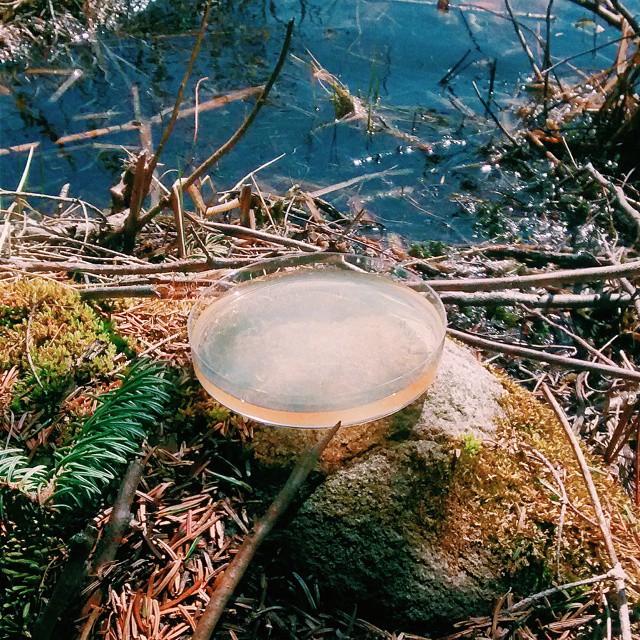
Not all yeast is harvested from picturesque moss-covered rocks beside bubbling brooks with a conveniently placed pine sprig for ambience.
These days brewers normally buy liquid yeast from three large companies in the US or dry yeast from a local distributor. The big guys don’t just buy individual vials of yeast, like I would when I make beer at home, they pitch gallons of it into a single batch of beer. When I make beer I also keep some yeast aside from each batch in the fridge to use in future brews, partly because I’m a dork who finds that sort of thing interesting, but also to save money. Brewers can do essentially the same thing, but they have to be a little more careful about it. Before storing, most will give their yeasts an acid wash to get rid of any possible infections that could have been introduced during brewing. I don’t know it for a fact, but I strongly suspect their storage techniques are a little more advanced than my collection of mason jars in the fridge door. Even with the best care, yeast strains will change their character a little every time you use them. To keep a consistent flavour, many brewers will only re-pitch eight or so times before going back to the original strain, where others will go up to 20 or 30 batches. Some brewers, especially the old-school guys who have been around forever just pitch ad infinitum, which can help explain the migrating flavour patterns you might have noticed in some of the brands that have been around a while.
Luckily for the guys at Escarpment, their appeal to local brewers extends beyond novelty strains and the marketability of a local product. Their big edge is geography. They’re much closer to Ontario brewers than any of the big yeast companies, which means they can get product to the brewers faster than the competition. Maybe their biggest advantage is they don’t have to cross any borders. Not only is it time consuming and expensive to do so, but it’s also not unheard of for customs to open a shipment of yeast and inspect its contents, in the process melting the ice packs the yeast was shipped with and sometimes tainting the shipment. What that all adds up to is Escarpment can not only deliver a superior product, but they can also add that small business personalized service for local brewers. They’re also cheaper than the big guys, which is probably the most important thing at the end of the day.
Given those advantages, demand has understandably been pretty brisk. Ever since they started producing commercial pitches in late June, demand has far outstripped supply. Like most craft producers in the province, they’re still best suited to meeting demand for one-off or seasonable beers with limited distribution. They can currently do pitches for 20 hl batches comfortably (that’s just shy of 60 kegs of beer, or about 100 standard-sized homebrew batches) or 40 hl if they put their minds to it. They’re adding capacity quickly, but the reality is demand is probably going to outstrip supply well into 2016.
We approached pro brewers and said ‘Hey, we’ve got these funky yeast strains, you want to give them a shot?’ That was a lot of fun.
-Angus Ross
Although drumming up orders hasn’t been much of an issue for them, I shouldn’t give you the impression that everything has been easy. Unlike almost every other part of the craft brewing industry that I’ve been exposed to, growing yeast is an area where nobody else in the business will help you out. Angus and Richard are a little lucky, since they can get some help from the other people involved in the yeast program at UoG, but even if they had local contemporaries the reality is nobody would share any information. Home brewers like me (have I mentioned enough times yet that I brew at home?) out there are probably a little confused as to why there’s so much secrecy in the industry, as yeast is pretty straight-forward to grow on the small scale. When you make the jump to the commercial scale things tend to get a lot more complicated. You have to deal with different nutritional, aeration, efficiency and other technical considerations that otherwise don’t exist. Plus since you can’t protect your strains, process is everything.
It’s not like starting a brewery where everyone is very willing to share what they’re doing. If you’re making beer you’re going to be able to find ten other people in your town or province who will teach you how to make your beer better. That doesn’t really work for the ingredient supply chain. Especially with yeast where the techniques that are used to grow yeast are largely kept as a trade secret.
-Richard Preiss
Since process is everything, the Escarpment guys wouldn’t tell me much about theirs. In fact, they even balked at me going to their lab to take pictures for the article, so they’re clearly keen to keep their process as secret as it can be. That said, here’s my best guess about their process. At heart, it’s not that different from making beer. The basic process is going to be that you start with wort that’s roughly the same as the beer the yeast will eventually be pitched into, since once yeast adapts to a local environment it will continue to perform better in that environment. In lower concentrations yeast tends to reproduce, whereas in higher concentrations it tends to produce more alcohol, so they’re definitely stepping up their batches in sizes, from beaker, to jug, to carboy. The equipment used (outside of the storage part of the operation, where they would need a centrifuge and a very cold freezer) is probably about on par with a high-end home brew or a brewery’s pilot system with a handful of fermenters and definitely temperature controllers to ensure precise fermentation. Given that their lab is inside a brewery, they probably buy or more likely trade for their wort. The trick in all of this is every yeast strain will behave a little differently. To produce an optimal product you have to know exactly how each strain behaves at each step of the process. How many steps do you need to get to your final cell count? What temperature should each step run at? How much nutrient should you give it at each step? What pH should the wort be? Getting to know each particular strain intimately is necessary to optimize this process, which is probably why while Escarpment have hundreds of strains banked, most of the beers you’ll see out there are only made with one a couple dozen of these strains so far.
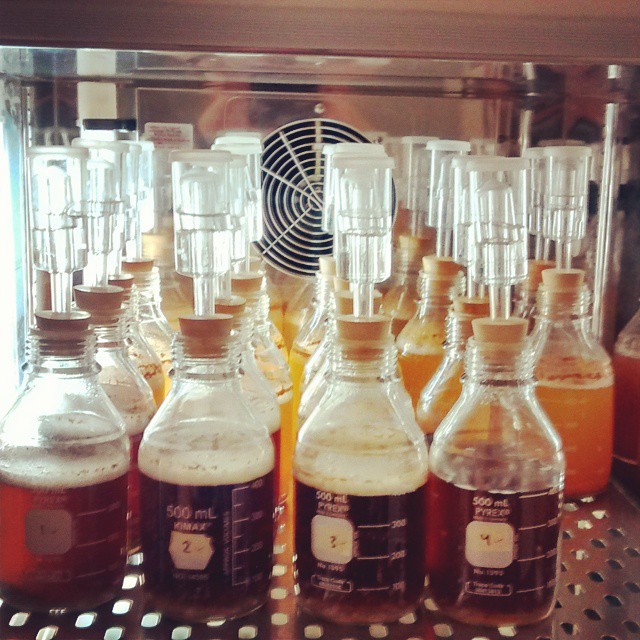
Growing strains for some yeast trials. A lot of what they do is try stuff out on smaller scales like this.
This actually touches on another potential area of business for Escarpment: Quality Control (QC). Earlier I touched on how breweries will try to pitch the same strain of yeast a few times themselves, to try to keep costs down. This is a good idea, but how are they to know if a yeast colony is healthy enough to be pitched again, or if some kind of infection has found its way into the pitch or the final product? The answer is QC. The actual process involves a lot of fairly mundane work carefully inspecting ingredients, machinery and finished product for infections, but this is something that big breweries do a lot of and craft brewers, particularly in Ontario ought to do a lot more of.
Have you ever had a beer from a brewery and liked it a lot, only to have it again a few months later and find it, sour, funky, dull or otherwise unsatisfying? This is far too common a thing in Ontario and while changes from batch to batch can be caused by many things, a lot of them could be caught and remedied by more stringent QC. If you look at regions in the US where craft beer is a little more mature than it is here, you’ll find that after the big surge in the number of craft brewers, there was a bit of a contraction as weaker breweries were pushed out of the market. The breweries that survive tend to be those that can consistently put out a high quality product and to do that I think you need good QC.
I’ve visited breweries in the US that are about the same size as most of the breweries that have started up in the last two or so years here. The key difference between those breweries in the US, that are achieving world-wide renown, and the ones of the same size here is the ones in the US have labs and lab staff. And they’re doing QC. This is a major difference that I don’t really see here.
-Richard Preiss
So, three thousand or so words later, what can the average home brewer or consumer who is reading this do to take advantage of this new company? Unfortunately, not much just yet. The big companies sell lots of yeast to home brewers, but that’s simply too much work for too little volume for a company like Escarpment to tackle directly at this point. The good news is the founders are avid home brewers, so they definitely have plans to eventually make their stuff available to us to use, via your local home brew supply shop, starting sometime in 2016. For now all we can do is keep an eye out for beers that are marketed as being made with Ontario yeast. In the past year there were quite a few of them that you might remember. The official beer of the Session beer festival this year was a gose which was made with a lacto strain donated by Escarpment. At that same festival the Ontario Craft Brewers had a tasty table beer that was a 25-brewery collaboration that used Escarpment yeast harvested from a local russet apple. A couple cider makers in Revel and West Avenue have, in my opinion, done some of the best things out there with Escarpment yeast in their wild cider offerings. Going forward, keep your eyes peeled for a LCBO listing from Royal City, more stuff from Folly and Burdock in their brewshops, lots of things at various festivals around the province and I’m sure lots more that will develop in the new year. Fans of wild strains in particular should keep a look out for details on a big wild yeast isolation project that should land sometime in the next year.
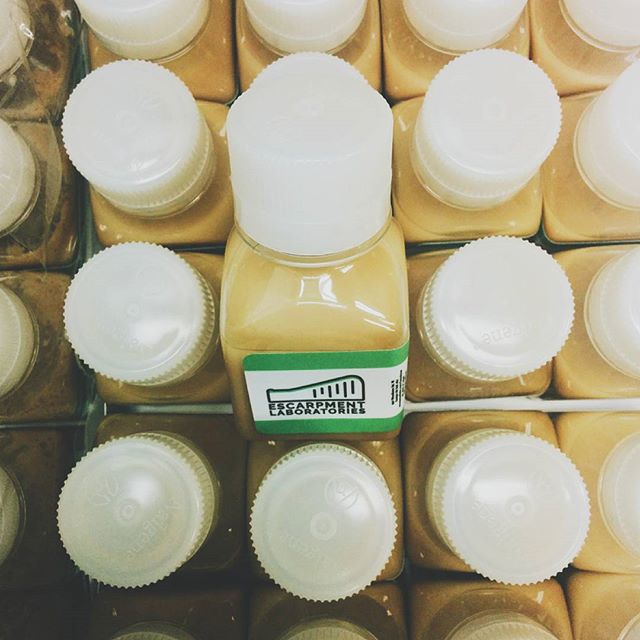
Coming Soon?
